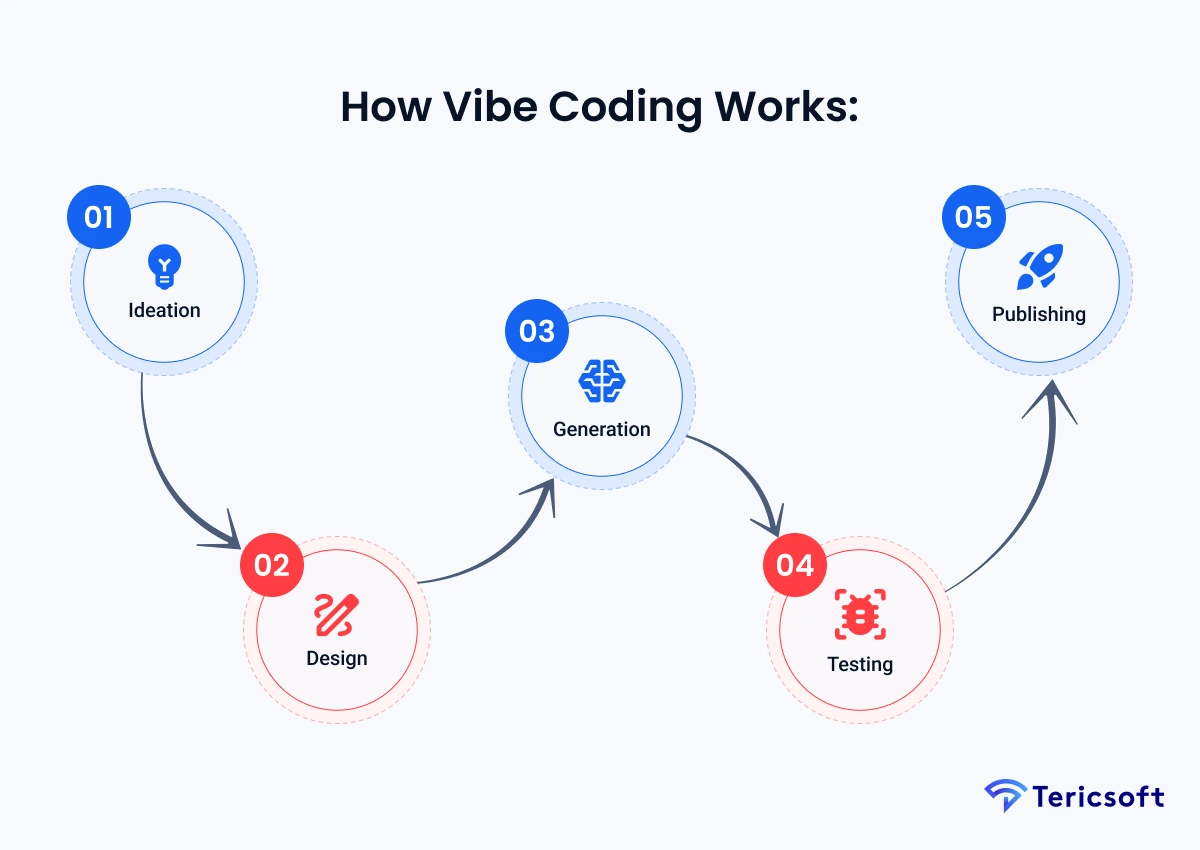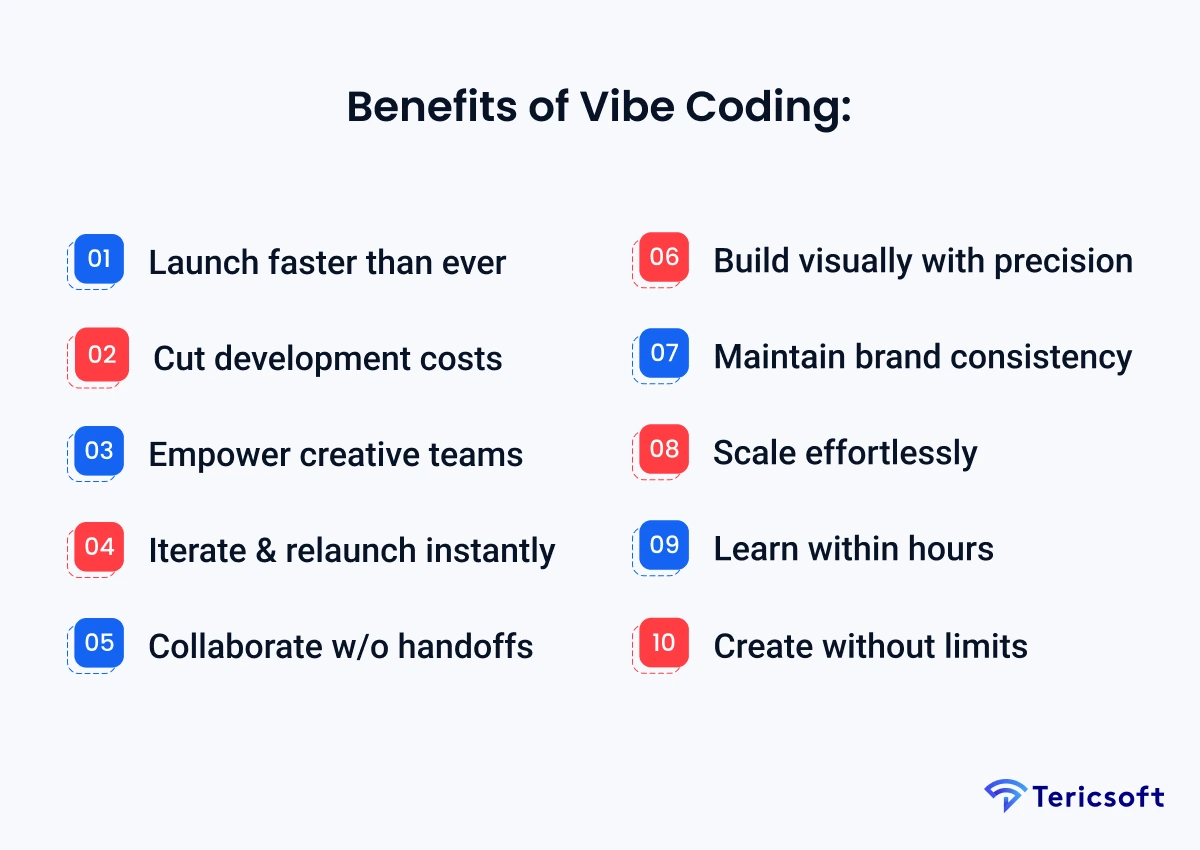
What is Vibe Coding? How AI is reshaping software creation by turning design intent into functional MVPs, enabling teams to build faster, collaborate seamlessly, and launch without writing code?
In today's hyper-fast digital market, speed is everything. But for decades, speed has often been the enemy of vision.
Founders, product managers, and designers have a clear idea, a vibe, for their application, only to see it get lost in translation. Long development cycles, technical compromises, and a frustrating gap between the Figma design and the final product have been the accepted, painful norm.
This friction point is where most great ideas slow down, lose momentum, or die.
But what if that friction disappeared? What if you could translate vision directly into a product? What if your design was the code, and the 'vibe' was the spec?
This is the promise of a new movement in software creation: Vibe Coding.
"There's a new kind of coding I call 'vibe coding', where you fully give in to the vibes... and forget that the code even exists."
— Andrej Karpathy, Founder of Eureka Labs
It's a shift from writing rigid instructions to expressing intent.
What Is Vibe Coding: A New Way to Build Software
At its core, Vibe Coding is an evolution of low-code and no-code development, supercharged by Artificial Intelligence. It's a development approach that prioritizes user experience and designer intent, using Al to translate visual designs, wireframes, and even plain-language descriptions into functional, working applications.
Consider a real-world scenario that's increasingly common: a UX designer finalizes a beautiful, interactive prototype in Figma. In the traditional workflow, this file is just a blueprint, destined to be manually rebuilt by a separate development team. But in a Vibe Coding workflow, that design is the starting gun. The designer feeds the file directly into an Al-powered platform. The Al instantly analyzes the visual "vibe," understands the components, auto-generates the front-end code, and scaffolds the backend logic. That static design becomes a live, interactive prototype in hours, not months.
That's Vibe Coding in action.
The Rise of Vibe Coding and Al-Assisted Development
This concept grew from "Vibe Coding," a term describing Al's ability to translate plain- language intent into working code. You tell the Al "what you mean," and it figures out "what to write."
Vibe Coding takes this a massive step further. It's not just about translating text commands. It adds creativity, context-awareness, and automation. It understands the vibe of your design: the spacing, the brand, the user flow, and preserves it during the build.
"You don't write the vibe; you design it."
Why Vibe Coding Matters in Today's Software Ecosystem
The demand for software is outpacing the supply of developers. Businesses need to move faster, test ideas, and pivot without costly, six-month build cycles. Vibe Coding addresses this gap by empowering the people who own the product vision (designers, product managers, and founders) to become creators.
The market reflects this shift.
"70% of new applications developed by enterprises will use low-code or no-code technologies."
Source: Gartner
Vibe Coding is the Al-native evolution of that trend, making agility and inclusivity the new standard for product creation.
Key Characteristics of Vibe Coding
The key characteristics of Vibe Coding distinguish it from traditional development. It's built on four core pillars:
- Visual Design-Driven Development: The process starts with the UI/UX. The visual design (in tools like Figma) is not just a guide; it's the source material for the application itself.
- Al-Guided Code Assistance: This is the engine. Al translates visual intent and natural language prompts into clean, functional code and logic.
- Real-Time Collaboration: Designers, product owners, and developers can work in a shared, Al-assisted environment, iterating on the product simultaneously.
- Rapid Publishing and Integration: Vibe Coding platforms are designed for speed, allowing you to deploy a functional MVP, test it, and integrate it with other APIs in a fraction of the time.
From Designer to Developer: Empowering Creative Builders
Historically, a designer's vision was locked behind a wall of technical implementation. Vibe Coding hands them the keys. For example, a designer using an Al platform like Super Engineer Al can convert their own Figma prototype into a working web app.
This democratizes software creation on an unprecedented scale.
The mantra is fast becoming "Design is the New Development", allowing creative builders to bring their ideas to life without writing a single line of syntax.
Limitations: Where the Vibe Stops
be clear, Vibe Coding is not a silver bullet. While perfect for MVPs, internal tools, and design-driven apps, it has limitations. For highly complex, mission-critical systems (like core banking logic, deep security compliance, or high-frequency trading platforms) the "vibe" must give way to meticulous, custom-built architecture. The key is knowing when to pair the speed of Vibe Coding with the depth of custom development.
How Vibe Coding Works: Inside the Al-Powered Workflow

So, how it works in practice? The Al-powered workflow fundamentally changes the product lifecycle.
- Ideation & Intent: Instead of writing a dense technical spec, you describe your idea's intent in plain language or build a simple wireframe.
- Design & Conversion: You create your high-fidelity Ul in a design tool like Figma. You then feed this design into a Vibe Coding platform (like Super Engineer Al or a Replit integration).
- Al Generation: The Al interprets the design, identifies components (buttons, forms, lists), and generates the front-end code (React, HTML/CSS, etc.) and a functional backend.
- Test & Publish: You can instantly publish the live app, test the user flow, and connect APIs to bring in real data.
This process is incredibly fast. Industry analyses show that building with an MVP approach can be up to three times faster than developing a full-featured product, allowing startups to get to market and start validating ideas almost instantly.
Role of Al in Vibe Coding Workflows
The role of Al is twofold. First, Natural Language Processing (NLP) and Generative Al work together to translate your intent (from "add a user login page"to analyzing a design) into a
structure. Second, the Al model is adaptive; it learns as you iterate, making subsequent changes and improvements even faster.
How Super Engineer Al Accelerates the Process
At Tericsoft, our proprietary framework, Super Engineer Al, is built to accelerate this exact process. It's an end-to-end system that allows teams to transform Ul mockups and product requirements into ready-to-deploy MVPs.
For example, a health-tech startup recently used Super Engineer Al to build a complex internal dashboard. What was quoted as a three-month custom development project was designed, built, and deployed in just 72 hours. This is the core of our Al-Powered MVP Development Services, which leverages Vibe Coding principles to deliver products faster.
The Benefits of Vibe Coding for Startups and Designers

The benefits for founders, designers, and product managers are transformative, directly addressing their biggest pain points.
- Speed to Market: Launch in days or weeks, not quarters.
- Cost Reduction: Save up to 70% on initial development costs by empowering existing teams and reducing dev hours.
- Empowerment: Designers and PMs stop being requestors and become creators.
- Iteration Flexibility: Test an idea, get feedback, modify the design, and republish the same day.
- Seamless Collaboration: Vibe Coding unites design, logic, and data in one shared environment. No more handoffs or miscommunication between teams.
- Visual Logic, Real Code: Create dynamic, production-grade experiences visually, without losing the precision and scalability of real code.
- Consistent Design Systems: Every build automatically aligns with your brand system and design tokens. No more visual drift or one-off components.
- Built for Growth: From MVP to full-scale product, the same codebase scales with your ambition.
- Learning Curve Advantage: Teams ramp up in hours, not months. No complex frameworks or new syntax to master.
- Creative Freedom: Focus on experience, not syntax. Build interfaces that feel alive and user flows that actually convert.
A retail startup, for instance, created a functional e-commerce MVP in just four days using a Vibe Coding approach, allowing them to test product-market fit before investing in a large-scale custom build.
Empowering Non-Technical Creators
This is the new reality: a Figma designer with a Replit Al plugin can deploy a Saas MVP. A marketer can build a custom landing page with an integrated database. Vibe Coding empowers these non-technical creators by abstracting the complex syntax and letting them focus on what they do best: the user experience and business logic.
Collaboration Between Developers and Designers
Vibe Coding doesn't replace developers; it elevates them. It creates a shared environment where designers and PMs can build the entire user-facing experience, freeing up senior developers to focus on what truly matters: complex backend logic, security, and scalability. The result is a more harmonious and efficient team.
Best Vibe Coding Tools to Use in 2025
The ecosystem of some of the best Vibe Coding tools is growing fast. Here are the platforms leading the charge in 2025:
- Super Engineer Al: Our end-to-end, Al-driven build system designed specifically to turn Figma designs and ideas into production-ready MVPs with speed.
- Replit + Ghostwriter Al: A powerful, collaborative in-browser IDE that uses Al for code generation, making it a favorite for rapid prototyping.
- Figma to App Integrations: A category of plugins and tools (like Anima or Locofy) that specialize in converting Figma designs into developer-friendly code.
- Bubble: A leading no-code platform that excels at building complex web applications with visual programming and database logic.
- FlutterFlow: A low-code platform for building native mobile apps (iOS & Android) from a single, visual codebase.
Choosing the Right Tool for Your Team's Skillset
Choosing the right tool depends on your goals. For a design-driven web app, a Figma-to-Al pipeline like Super Engineer Al is ideal. For a content-heavy site, Webflow might be the answer. For a native mobile app, FlutterFlow is a strong contender. The key is to assess your team's existing skills and the technical complexity of your target product.
Vibe Coding vs Custom Software Development: Choosing the Right Path
The most common question we get is about Vibe Coding vs Custom Software Development. This isn't an either/or choice; it's about picking the right tool for the right job.
Think of it as a spectrum:
When to Choose Vibe Coding
Choose Vibe Coding when your primary goal is speed, validation, and iteration. An EdTech startup, for example, could build its entire onboarding app in three days to pilot test with a user group. This is the power of Vibe Coding: getting a real product into real users' hands, fast.
When Custom Development is the Better Choice
Choose custom development when your requirements are non-negotiable. A FinTech company needing to meet strict PCI compliance and handle millions of secure transactions should opt for a custom build. The same goes for performance-critical applications where every millisecond counts.
The Future of Vibe Coding: Al as the New Co-Developer
The future of Vibe Coding is Al evolving from a tool to a teammate. We are moving toward "Agentic Vibe Coding," where Al agents co-build, co-test, and co-deploy alongside human teams.
You won't just ask the Al to "build a button"; you'll ask it to "analyze user feedback from last week and redesign the checkout flow to improve conversion."
This market is exploding, with low-code and Al-assisted development expected to hit over $100 billion by 2030. The future designer isn't just a designer; they are a product builder, empowered by Al-native platforms to bring any vision to life.
How Tericsoft Leads the Vibe Coding Movement
At Tericsoft, we are not just observers of this shift; we are active builders. We. We help founders and enterprises build Al-powered MVPs faster through our proprietary framework: Super Engineer Al.
By combining the principles of Vibe Coding with agentic Al systems, we enable teams to transform ideas, wireframes, or Figma designs into working, deployable applications, often without writing traditional code.
Our Al-powered MVP development services are designed to:
- Accelerate your time-to-market through AI-assisted automation.
- Empower your designers and product leaders to co-create directly with AI.
- Deliver experience-led, production-ready MVPs that can scale into full-fledged platforms.
If you’re exploring how Vibe Coding and AI can help you build faster and smarter, you're in the right place.









